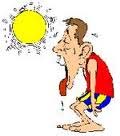Ehso.emory.edu

1762 Clifton Road, Suite 1200
Atlanta, Georgia 30322
FAX: (404) 727-9778
SAFETY TOOLBOX TRAINING : WORKING SAFELY IN THE HEAT-KEEP IT COOL!
SUPERVISOR INSTRUCTIONS:
Use toolbox trainings to spark safety discussions during monthly meetings with employees Submit the employee sign-in sheet to your designated administrative assistant /training coordinator as a
record of training
It's that time of year again! With summer rapidly approaching heat stress needs to be addressed. Georgia summers can be excruciating, and no matter if you work indoors or outside you should understand how to deal with extreme heat. If the body is unable to cool itself, a worker can experience heat stress which occurs as a result of the body gaining heat faster than it removes heat. The body temperature rises and a person experiences heat stress.
Early signs and symptoms of heat stress include headache, nausea, decreased
efficiency, reduced coordination and alertness, increased irritability, light-headedness, dizziness, fainting, and swelling of hands, feet, and ankles (usually one to two days after first exposure).
Remove the worker from the hot environment to rest in a cool place and to drink
cool water. Have the worker rest with his or her legs and feet elevated. Have the worker assessed by medical personnel. Keep the worker under observation until he is fully recovered from the effects of the heat.
W arning: Aspirin or non-steroidal anti-inflammatory drugs should
not be given to workers to relieve symptoms of heat stress.
In order of seriousness, the following conditions could arise as a result of heat stress. From low to high -
these are:
Heat rash: People working in hot, humid conditions may develop a rash that is accompanied by intense
itching spasms and prickly sensations. Heat rashes are most likely to occur in areas where clothing traps
hot and humid air next to the skin.
Avoid repeated exposure to heat. Change all clothing often when sweating is profuse.
Always wear clean, starch-free, loose-fitting clothing.
Leave the hot environment, preferably until the rash has healed. Keep the affected area
clean, cool, and dry as much as possible.
Heat syncope (fainting): Heat syncope is a fainting (syncope) episode or dizziness that usually occurs
with prolonged standing or sudden rising from a sitting or lying position.
Factors that may contribute to heat syncope include dehydration and lack
of acclimatization.
• Symptoms include lightheadedness, dizziness, or fainting
• Workers with heat syncope should sit or lie down in a cool place
when they start to feel symptoms and drink cool water
Toolbox Training_Heat Stress_2.docx
Revision Date: 31-May-11
SAFETY TOOLBOX TRAINING : WORKING SAFELY IN THE HEAT-KEEP IT COOL!
Heat cramps: Heat cramps are painful muscle cramps caused by excessive sweating during strenuous
activity, which depletes the body of salt and water.
Place the worker at rest in a cool place. Give the worker cool water to drink. Salt
tablets and sports drinks (e.g. Gatorade®, Powerade®, etc.) are not recommended. Rest alone is not sufficient — heat cramps often occur in the resting state after a work shift.
Heat cramps are cured only after the depleted salt has been replaced. More importantly,
continued work under conditions of heat stress can lead to heat exhaustion, a more serious disorder. When a worker has cramps, along with other symptoms such as fatigue, weakness, headache, gastrointestinal illness, or changes in mental state, the worker may already be suffering from heat exhaustion or heat stroke.
Heat exhaustion: Heat exhaustion is the body's response to an excessive loss of the fluids and salt
contained in sweat.
Signs and symptoms include general weakness, tiredness, poor muscle control, dizziness
and fainting, headache and nausea, pale, cool, and clammy skin, profuse sweating, rapid pulse, rapid shallow breathing and muscle cramps.
Place the worker at rest in a cool place. Elevate the worker's feet and give cool water to
drink, if not vomiting. Seek medical attention immediately.
Heat stroke: Heat stroke is a life-threatening condition in which the body's core temperature rises
above 106°F. At core body temperatures over 106°F, sweating often stops. The body is unable to
get rid of heat and the body temperature may continue to rise. The person's mental functions may
become disturbed. Without immediate first aid, heat stroke can result in a coma, permanent brain damage,
or death. This is an emergency situation.
Heat stroke can come about suddenly and without warning. Signs and symptoms include hot, dry, flushed skin (usually with no sweating), agitation
and confusion, headache, nausea, vomiting, rapid shallow breathing, irregular pulse, possible seizures, loss of consciousness, and possible shock and cardiac arrest.
Attempt to cool the worker, and arrange for medical attention as quickly as possible. When the worker is not breathing, or is unconscious, regular first aid procedures should
be started by a trained individual. Move the worker to the coolest area available. Loosen or remove outer clothing. Continue to cool the worker by sponging, spraying him with cool water, or by covering him with damp sheets, while waiting for medical help to arrive. Additional cooling may be provided by fanning the worker.
Warning: Only employees trained in first aid should attempt to give first aid. Never exceed
your level of First Aid, cardiopulmonary resuscitation (CPR), or automated
external defibrillator (AED) training.
PR E V E NT ING H E AT I L L NE SS The following are safety guidelines to protect workers from heat hazards:
Acclimatization-Adjusting Your Body for Heat Exposure
• During the first few days of working in heat the body needs time to adjust, so start work
slowly, and increase pace gradually;
• Report to a supervisor if returning to work after an absence or illness, or when changing
from a cool to a hot/humid environment;
• During a heat wave, there is still a risk for illness even if the body is acclimatized.
Toolbox Training_Heat Stress_2.docx
Revision Date: 31-May-11


SAFETY TOOLBOX TRAINING : WORKING SAFELY IN THE HEAT-KEEP IT COOL!
Fluids-Avoiding Dehydration
• Increase fluid intake during hot weather regardless of activity level; • Drink two to four glasses (16-32 ounces) of cool water each hour; • Don't wait until you are thirsty to drink;
Skin Protection-Dressing Properly for the Job
• Wear a wide-brimmed hat and loose-fitting, long-sleeved, light-colored clothing to help
with ventilation;
• Use extra caution if you are required to wear clothing on the job which limits
evaporation--you could succumb to heat stress much more quickly;
• Wear sunglasses; • Apply sunscreen (SPF 15 or higher) 15-30 minutes prior to going outdoors on areas of
the body that will be exposed to the sun and re-apply every two hours;
Administrative Controls-How Can Supervisors/Management Help?
• Encourage employees to take more frequent breaks and hydrate anytime they feel necessary; • Be aware that some medications and illnesses may increase heat-related risks; • Provide a break area out of the direct sun or in an air conditioned building; • Schedule tasks to avoid heavy physical activity during the hottest parts of the day; • Provide cool drinking water and encourage its consumption; • Use additional workers for jobs or slow down the pace of the work; • Make sure everyone understands the signs and symptoms of heat stress; • Schedule routine maintenance and repairs during cooler seasons of the year;
If feeling symptoms, immediately seek shelter and aid!
Toolbox Training_Heat Stress_2.docx
Revision Date: 31-May-11
SAFETY TOOLBOX TRAINING : WORKING SAFELY IN THE HEAT-KEEP IT COOL!
REMEMBER: HINDSIGHT EXPLAINS THE INJURY THAT FORESIGHT WOULD HAVE PREVENTED
QUESTIONS FOR DISCUSSION:
1. True or False. Workers suffering from heat stress should be given aspirin.
Answer: Neither aspirin nor non-steroidal anti-inflammatory drugs should not be given to
workers to relieve symptoms of heat stress.
2. True or False. Heat stroke is a life-threatening condition in which the body's core temperature
rises above 106°F.
Answer: True
3. True or False. It is more difficult for sweat to evaporate when the humidity is high.
Answer: True
4. True or False. Allowing for frequent breaks when working in the heat is a way to prevent heat
illness.
Answer: True
Toolbox Training_Heat Stress_2.docx
Revision Date: 31-May-11
Source: http://www.ehso.emory.edu/content-guidelines/Toolbox/ToolboxTraining_HeatStress.pdf
Instructions for Use Erythropoietin ELISA Enzyme immunoassay for the quantitative determination of Erythropoietin (EPO) in human serum. Flughafenstrasse 52a Phone: +49 (0)40-53 28 91-0 D-22335 Hamburg, Germany Fax: +49 (0)40-53 28 91-11 Erythropoietin ELISA (NM56011) INTENDED USE
Reference: Biol. Bull. 204: 68 – 80. (February 2003)© 2003 Marine Biological Laboratory Collection and Culture Techniques for Gelatinous KEVIN A. RASKOFF1,*, FREYA A. SOMMER2, WILLIAM M. HAMNER3, AND KATRINA M. CROSS4 1 Monterey Bay Aquarium Research Institute, Moss Landing, California 95039-9644; 2 Hopkins Marine Station, Pacific Grove, California 93950-3094; 3 University of California, Los Angeles, California










